Most wooden pallets get treated before use, especially for international shipping. Understanding pallet treatments is key before we dive into the details. The treatment method influences how pallets are reused and their environmental impact.
Types of Pallet Treatments
Wooden pallets are treated in different ways. Each method helps with pest control or makes them last longer. Knowing these treatment methods is key to deciding if a pallet is safe for your needs.
Heat Treatment (HT)
Heat treatment is currently the most common method used for treating wooden pallets. This process heats the wood to about 56°C (132.8°F) for at least 30 minutes. Heat treatment mainly aims to get rid of harmful insects, larvae, eggs, and other pests in the wood.
Heat-treated pallets are seen as better for the environment. They don’t use chemicals. This treatment method follows global standards. It especially adheres to the International Standards for Phytosanitary Measures (ISPM-15). These rules control how wood packaging materials move between countries.
Methyl Bromide Fumigation (MB)
In the past, many pallets were treated with methyl bromide. This toxic pesticide was used to fumigate the wood. Since 2010, the use of methyl bromide has been greatly limited. This is because of worries about its effects on human health and its role in harming the ozone layer.
Older pallets treated with methyl bromide might still be around. This is especially true for those nearing the end of their useful lives. Avoid these pallets for food projects or indoor use. They may pose health risks.
Pressure Treatment
The question of whether pallets are pressure treated is more complex. Pressure treatment is the process of soaking wood in chemicals. This makes the wood resistant to decay, mold, and insect damage. This process uses high pressure to push a water-based preservative deep into the wood.
Older pallets may have been treated with chromated copper arsenate (CCA). This treatment has been phased out for many home uses because of health concerns. CCA-treated wood starts off with a greenish tint. Over time, it fades to a silvery color, similar to untreated wood. This change makes it hard to identify visually.
Modern pressure-treated wood typically contains compounds such as:
- Alkaline copper quaternary (ACQ)
- Copper azole (CA)
- Micronized copper azole (MCA)
Pressure treatment boosts durability, but it can release chemicals over time. This raises concerns for some uses.
Kiln Drying
Kiln drying and heat treatment are often mixed up, but they have different goals. Kiln drying reduces moisture in wood. This makes pallets lighter and stronger. It also helps prevent warping and cracking. This process is great for pallets stored indoors. It’s also good for products that can’t handle moisture.
However, kiln drying alone does not meet ISPM-15 standards for international shipping. A kiln-dried pallet still needs heat treatment for international transport.
How to Identify Treated Pallets
Knowing how to identify the treatment method on a pallet is key. This helps you decide if it’s safe for different uses.
IPPC Marking System
Pallets for international shipping must have an IPPC logo stamped on them. This stamp provides essential information about the pallet’s treatment:
- Two-letter country code indicating where the pallet was produced
- Unique number assigned to the producer by the National Plant Protection Organization
- Treatment code: “HT” for heat treatment or “MB” for methyl bromide fumigation
- Possibly “DB” to indicate the wood has been debarked
After treating a pallet, a certification label will be stamped on its side. Retreat and restamp the entire pallet if it has been fixed with untreated wood.
Visual Inspection
Visual inspection can give hints about how a pallet was handled, but it’s not always dependable.
- Pressure-treated wood may have a greenish tint when new, though this fades over time
- Signs of chemical spills or contamination can show that the pallet isn’t safe to reuse.
- Untreated wood may show more signs of wear, insect damage, or moisture absorption
Some pallets, especially those used within a country, may be untreated. They might not have official IPPC markings. In such cases, caution is advised when repurposing them.
Safety Considerations for Different Uses
When repurposing pallets, the treatment method is key for safety.
Food-Related Uses
For vegetable gardens, food storage, or any food-related applications, caution is strongly advised:
- Heat-treated (HT) pallets are safer because they have no chemicals. However, it’s still important to think about what was transported on them.
- Don’t use methyl bromide (MB) treated pallets for food. They may have toxic residues.
- Don’t use pressure-treated pallets, especially older ones with CCA, for growing food. They might leak arsenic.
- Untreated pallets can still carry bacteria. This risk depends on what they previously held.
Indoor Projects and Furniture
For indoor projects such as furniture or decorative items:
- Heat-treated pallets are the safest option, though proper finishing is still recommended
- Sanding pallet wood can create dust with harmful substances. So, it’s important to wear respiratory protection.
- Proper sealing and finishing can help contain any potential contaminants in the wood
Outdoor Uses
For outdoor projects like garden structures or decorative elements:
- Pressure-treated pallets may resist weather better. However, their unknown chemicals can be risky.
- Untreated pallets can stay outside for a few months. However, they will eventually get mold or rot if not weatherproofed properly.
- You can make heat-treated pallets better at resisting weather by using natural oils. Linseed and tung oil are good options.
Useful Table Summarizing
| Treatment Method | Description | Identification | Purpose/Effect | Safety Considerations | Typical Use Cases |
|---|---|---|---|---|---|
| Heat Treatment (HT) | Wood heated to ≥56°C for ≥30 minutes to kill pests without chemicals | IPPC stamp with “HT” | Pest elimination, complies with ISPM 15 | Safe for most uses, no chemical residues; preferred for food-related and indoor use | International shipping, DIY projects, gardens |
| Methyl Bromide Fumigation (MB) | Wood fumigated with toxic pesticide methyl bromide to kill pests | IPPC stamp with “MB” | Pest elimination | Highly toxic; avoid any contact; not safe for home use or burning | Older pallets, restricted use in international shipping |
| Pressure Treatment | Wood impregnated under pressure with chemical preservatives (e.g., CCA, ACQ, CA) | Sometimes greenish tint; no standard stamp | Resistance to rot, mold, insects | Contains chemicals; avoid for food contact or indoor use; handle with care | Outdoor storage, humid environments |
| Kiln Drying | Wood dried to reduce moisture content, not a pest treatment | No specific stamp; sometimes “KD” | Reduces moisture, prevents warping | Safe but does not meet ISPM 15 pest treatment requirements | Domestic pallets, moisture-sensitive cargo |
| Bio-Treatment | Use of organic materials (plant oils, fungi) to repel pests | Rare; no standard stamp | Eco-friendly pest resistance | Generally safe and sustainable; limited commercial use | Eco-conscious logistics |
| Combination Treatments | Heat plus chemical treatments combined for enhanced protection | Varies; may have multiple marks | Pest, fire, rot resistance | More durable but chemical exposure risk; higher cost | Heavy-duty industrial |
Just a heads up about pallets – you’ll want to check for that IPPC stamp to see how they’ve been treated. This stamp shows where they’re from, who made them, and what treatment they got.
Stay away from pallets marked with “MB” – that’s methyl bromide and it’s pretty toxic stuff.
If a pallet doesn’t have a stamp or you’re not sure about its treatment, better safe than sorry – don’t use it for food or inside your home.
Watch out for pressure-treated pallets too. They might not be clearly marked, but they can leach chemicals.
Those painted pallets? They usually belong to rental companies and aren’t meant for you to take home and use.
When you’re working with pallets, protect yourself! Wear proper gear to avoid getting hurt from nails, splinters, or saw accidents.
Understanding these basics will help you pick the right pallets for your projects and keep you safe while working with them.



Leave a Reply